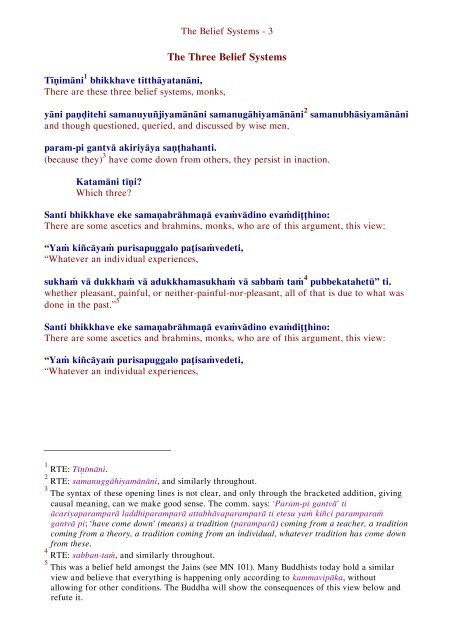Titthāyatanasuttaṁ, The Discourse about the Belief Systems
A Pāli and English line by line (interlinear) version of this important discourse from the canon, which contrasts the Buddha’s teaching on causation, with that of outside belief systems (Aṅg. 3.62)
A Pāli and English line by line (interlinear) version of this important discourse from the canon, which contrasts the Buddha’s teaching on causation, with that of outside belief systems (Aṅg. 3.62)
Create successful ePaper yourself
Turn your PDF publications into a flip-book with our unique Google optimized e-Paper software.
<strong>The</strong> <strong>Belief</strong> <strong>Systems</strong> - 3<br />
<strong>The</strong> Three <strong>Belief</strong> <strong>Systems</strong><br />
Tīṇimāni 1 bhikkhave titthāyatanāni,<br />
<strong>The</strong>re are <strong>the</strong>se three belief systems, monks,<br />
yāni paṇḍitehi samanuyuñjiyamānāni samanugāhiyamānāni 2 samanubhāsiyamānāni<br />
and though questioned, queried, and discussed by wise men,<br />
param-pi gantvā akiriyāya saṇṭhahanti.<br />
(because <strong>the</strong>y) 3 have come down from o<strong>the</strong>rs, <strong>the</strong>y persist in inaction.<br />
Katamāni tīṇi?<br />
Which three?<br />
Santi bhikkhave eke samaṇabrāhmaṇā evaṁvādino evaṁdiṭṭhino:<br />
<strong>The</strong>re are some ascetics and brahmins, monks, who are of this argument, this view:<br />
“Yaṁ kiñcāyaṁ purisapuggalo paṭisaṁvedeti,<br />
“Whatever an individual experiences,<br />
sukhaṁ vā dukkhaṁ vā adukkhamasukhaṁ vā sabbaṁ taṁ 4 pubbekatahetū” ti.<br />
whe<strong>the</strong>r pleasant, painful, or nei<strong>the</strong>r-painful-nor-pleasant, all of that is due to what was<br />
done in <strong>the</strong> past.” 5<br />
Santi bhikkhave eke samaṇabrāhmaṇā evaṁvādino evaṁdiṭṭhino:<br />
<strong>The</strong>re are some ascetics and brahmins, monks, who are of this argument, this view:<br />
“Yaṁ kiñcāyaṁ purisapuggalo paṭisaṁvedeti,<br />
“Whatever an individual experiences,<br />
1 RTE: Tīṇīmāni.<br />
2 RTE: samanuggāhiyamānāni, and similarly throughout.<br />
3 <strong>The</strong> syntax of <strong>the</strong>se opening lines is not clear, and only through <strong>the</strong> bracketed addition, giving<br />
causal meaning, can we make good sense. <strong>The</strong> comm. says: ‘Param-pi gantvā’ ti<br />
ācariyaparamparā laddhiparamparā attabhāvaparamparā ti etesu yaṁ kiñci paramparaṁ<br />
gantvā pi; ‘have come down’ (means) a tradition (paramparā) coming from a teacher, a tradition<br />
coming from a <strong>the</strong>ory, a tradition coming from an individual, whatever tradition has come down<br />
from <strong>the</strong>se.<br />
4 RTE: sabban-taṁ, and similarly throughout.<br />
5 This was a belief held amongst <strong>the</strong> Jains (see MN 101). Many Buddhists today hold a similar<br />
view and believe that everything is happening only according to kammavipāka, without<br />
allowing for o<strong>the</strong>r conditions. <strong>The</strong> Buddha will show <strong>the</strong> consequences of this view below and<br />
refute it.


















